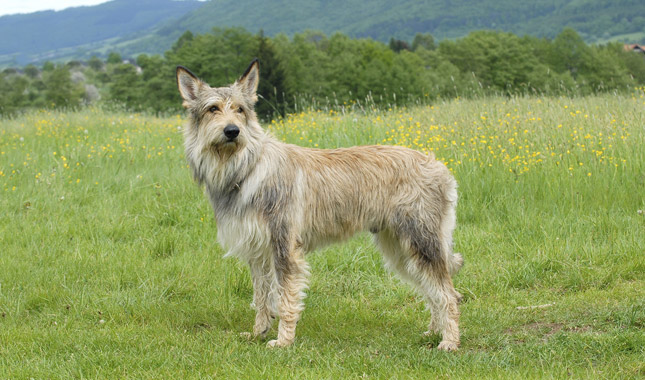Other names: Picard, Berger de Picardie, Picardy Shepherd, Picardy Sheepdog.
The Berger Picard or Picardy Shepherd is French herding originating in Picardy. These dogs nearly became extinct after both World War I and World War II and remain a rare breed.
Appearance
The Berger Picard is a medium-sized, well-muscled dog, slightly longer than tall with a tousled yet elegant appearance. Their ears are naturally erect, high-set and quite wide at the base. Their eyebrows are thick but do not shield their dark frank eyes. They are known for their smile. Their natural tail normally reaches to the hock and is carried with a slight J-curve at the tip. Their weather-proof coat is harsh and crisp to the touch, not excessively long with a minimal undercoat. Coat colours fall into two colours, fawn and brindle with a range of shade variations.
Temperament

The Berger Picard’s attributes include a lively, intelligent personality and a sensitive and assertive disposition that responds quickly to obedience training. Picards are easygoing and mellow but can be reserved towards strangers. They require a lot of socialization during the first two years of their lives.
Picards are energetic and hard-working, alert, and are not excessive barkers. Some Picards are notoriously picky eaters.
The breed also has a well-developed sense of humour, making them an endearing companion, and they continue to be used very effectively as both sheep and cattle herders in their native land and elsewhere.
Like many herding breeds, Picards require human companionship. Since they can be demonstrative to their owners and enthusiastic towards other animals, formal obedience training and positive socialization are important.
History
In 2018 a genetic study found that just prior to 1859, a broadly distributed European herding dog had given rise to the German Shepherd Dog, the French Berger Picard, and the five Italian herding breeds: the Bergamasco Shepherd, Cane Paratore, Lupino del Gigante, Pastore d’Oropa, and the Pastore Della Lessinia e del Lagorai.
One author believes that the Berger Picard was brought to northern France and the Pas de Calais in the 9th century by the Franks. Some experts insist that this breed is related to the more well-known Briard and Beauceron, while others believe it shares a common origin with Dutch and Belgian Shepherds. Although the Berger Picard made an appearance at the first French dog show in 1863, the breed’s rustic appearance did not lead to popularity as a show dog.
The breeding stock of the Berger Picard was decimated by the ravages of World War I and World War II. With its population concentrated on the farms of north-eastern France, trench warfare in the Somme reduced the breed to near extinction. The prevalence of the breed worldwide remains limited, even in its native country.
Germany has approximately 500 of this breed. There are approximately 400 Berger Picards in the United States and Canada. The Berger Picard Club of America and the Berger Picard Club Canada were formed to help promote and protect this breed. The Berger Picard was fully recognized in the herding group by the American Kennel Club on 1 July 2015. It is also in the herding group category of the Canadian Kennel Club.
The interim breed standard for the Picardy Sheepdog was approved and the breed was accepted on to the import register of the United Kingdom’s Kennel Club on 1 April 2014. The breed can only be shown in Import classes and is awaiting official registration of the proposed Picardy Sheepdog Club. The Picard was first shown at Crufts in March 2016 in the Pastoral (Herding) Group.
